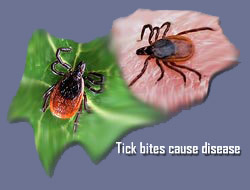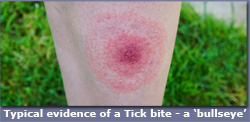 |
|
|
|
Regular readers of this website will know that Unionsafety has featured news and information, as welll as video productions about Tick Bites and the associated serious illness called Lyme Disease that those bitten by a Tick; can be infected with. CWU has always issued warniongs during the season in which Tick Bites can become a very common risk for all who venture out into parks, woodlands, and even near farmland hedgerows via public footpaths; and this year is no different - well apart from two new diseases acquired from Tick Bites that have now been found in the UK! Dave Joyce, CWU's National Health, Safety, and Environment Officer reports via his latest letter to all the Union's branches (LTB431/20) on these two new illnesses caused by Tick Bites:
· Several diseases are carried by UK Ticks. For a summary of the latest news on TBDs see below. Public Health England (PHE) has called for people to be ‘Tick-Aware’ as they confirmed the diagnosis of the first case of Babesiosisa and a second case of Tickborne Encephalitis (TBE) in UK. Babesiosis is caused by a parasite which infects red blood cells whilst TBE is a viral infection that affects the central nervous system. Both are rare infections spread by the bite from an infected Tick. Both patients have been transferred to hospital, where they are receiving appropriate treatment and supportive care. This year, PHE has been undertaking surveys of various sites in Devon close to where the person with Babesiosis lives, collecting and testing hundreds of Ticks. PHE has tested deer blood samples from Hampshire in areas near to where the person with probable TBE lives and they have shown evidence of likely TBE virus infection, which matches similar results found in 2019 surveys. The risk of Babesiosis or TBE for the general public is remains low. Babesiosis Tick-Borne Encephalitis (TBE) Individuals developing flu-like symptoms after being bitten by a tick should visit their GP or go to hospital if they:-
get pain when looking at bright lights have a seizure (fit) have a change in behaviour – such as sudden confusion develop weakness or loss of movement in part of the body You can download the full LTB here and visit the Unionsafety E-Library to download the relevent advice and ifnormation on Tick Bytes and on Lyme Disease in particular. Whislt the PHE claim they regularly undertakes work to understand the potential risks of Tick-borne infections in England, they have always played down the affects of Lyme Disease; as previously reported by Unionsafety. You can read a special report by this website's editor first published in 2012 entitled: Lyme Disease Invisible And Misdiagnosed Devastates Sufferers As NHS And Govt Remain Idle A further detailed report entitledLyme Disease – Patients Languish While Facts Are Buriedpublished in 2013. Each year, Unionsafety has published articles and information about Tick Bites. The following documents included in this and other LTB's are also available from the Unionsafety E-Library Database: HPA Fact Sheet on Lyme Disease - HPA Fact Sheet on Biting Bugs - New Forest District Council Leaflet on Tick Bites and Lyme Disease Source: CWU / Unionsafety See also:
|

 What you need to know about ‘Tick-borne’ diseases (TBDs):
What you need to know about ‘Tick-borne’ diseases (TBDs):  get a stiff neck and a severe headache
get a stiff neck and a severe headache